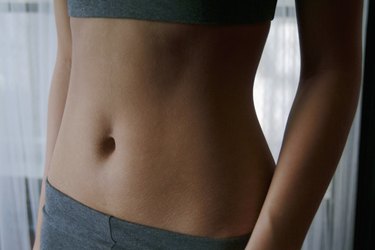
Body shapers give the illusion of a smaller figure, flattening the stomach and bringing in the waist line, and it's only natural to want those changes to be permanent. Since body shapers make it more difficult to breathe, it might seem that you would burn more calories during exercise due to the increased stress on your body. But in reality, wearing a body shaper during a workout can do more harm than good.
Tip
While a body shaper might make you feel more fit during exercise, it can restrict your breathing and negatively impact your ability to sustain physical activity.
Video of the Day
Consider the Compression
Body shapers compress the stomach and push down on the diaphragm, preventing you from taking a full breath. Aerobics and strength-training increase your respiratory rate, and if you're unable to breathe effectively, you'll find yourself tiring more quickly than usual. A less productive workout means fewer calories burned, undermining your weight loss efforts.
Video of the Day
Prioritize Your Safety
Body shapers restrict diaphragmatic breathing, resulting in shallower breaths. During intense exercise, the body requires sufficient oxygen to perform; without it, you can end up feeling dizzy and weak. Wearing a body shaper is fine if you intend to remain mostly stationary, but if you're doing cardio, yoga or weightlifting to lose weight, you could end up fainting due to a lack of oxygen. Furthermore, the fabrics used in some body shapers aren't very breathable and prevent sweat from escaping. Sweat regulates your body temperature and helps to keep you cool during exercise.
Read more: Benefits of Deep Breathing
Dress for Movement
It's always a good idea to wear comfortable, loose-fitting clothes while working out. If you're working out in a hot climate, opt for light-weight fabrics with light colors; in the winter, wear multiple thin layers, and choose dark colored clothing. You should also avoid wearing plastic, leather or rubberized clothing when exercising.
Tighten Your Abs
Sucking in your stomach utilizes the transversus abdominis muscle, the innermost muscle of the abdomen. This muscle stabilizes the core, improving posture and protecting the spine. An exercise technique known as the "stomach vacuum" can strengthen the transversus abdominis, helping to flatten your stomach. Body shapers only compress fat or push it to another location, and therefore don't effectively work the deepest abdominal muscles.
HOW TO DO IT: Lie on your back on a firm surface. Bend your knees, place your feet on the floor and put your hands on your hips.
Tighten your abs as if you are pulling your belly button back toward your spine. You should feel the muscles under your finger tips tighten. Hold for three to five seconds, then relax. Repeat 10 times.
Read more: Stomach Vacuum Exercise
Make It Harder
Once you've mastered the basic stomach vacuum exercise, make it harder by adding arm and leg movement. Try the following while maintaining tight abs:
- March one foot at a time
- Lift one arm overhead
- Lift both arms together, overhead
- Lift the opposite arm and knee together
- Lift your hips off the ground to make a bridge